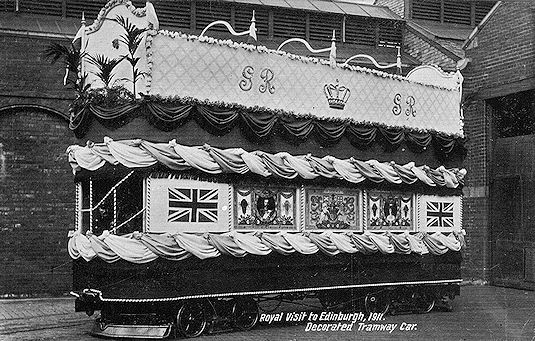

In 1911, King George V made a historic visit to Edinburgh, the capital of Scotland. He was the first British monarch to visit the city since 1822, which was by his grandfather, King George IV. The 1911 visit was part of the celebrations for the coronation of the King and his wife, Queen Mary. The royal couple arrived by train at Waverley Station and were greeted by a large cheering crowd. They then proceeded to the Palace of Holyroodhouse, where they stayed for four days. During their stay, they attended various events and ceremonies, such as the opening of the Scottish National War Memorial, the laying of the foundation stone of the new Royal Infirmary, and the presentation of new colours to the Royal Scots Regiment. For the visit, Edinburgh and District Tramways decorated one of their cable trams, as seen in this postcard published by J. Valentine and Co. of Dundee.
The first trams in Edinburgh were the horse cars of the Edinburgh Street Tramways Company, which began operation in 1871. The Edinburgh cable tram system was a pioneering standard gauge public transport network that operated from 1888 to 1923. It was started in January 1888 by the Edinburgh Northern Tramways Company, formed by Dick, Kerr & Co. Ltd, and which had had two routes, totalling 2.61 miles, with two single-deck and 18 double-deck cable trams. In 1893 the Edinburgh Street Tramways Company was taken over by the Edinburgh and District Tramways Company, also formed by Dick, Kerr, who added the Edinburgh Northern's tramways in 1897. The decision was taken to convert all the tramways to cable operation, which by 1918 had brought the system about twenty-five miles of route and owning 211 four-axle double-deck cable trams, mostly open top. Some cable cars were conversions from horse trams and in their turn, many cable cars were later converted to electric. The livery was madder lake and white. In 1919 the Edinburgh and District was taken over by Edinburgh Corporation, who acquired a then existing fleet of 209 cable cars. The Corporation decided to electrify its tramway, which was completed in 1923.
The cable tram system was powered by steam engines located at the depots along the routes at Shrubhill, Henderson Row, Tollcross and Portobello. The trams were pulled along by means of continuous loops of steel cable running in conduit between the running rails in a manner similar to that used today in San Francisco. There were thirteen main and twelve auxiliary cables, the longest running about six and a half miles. The trams were controlled by a gripman who could attach or detach the tram from the cable as needed. In its day Edinburgh was the fourth largest cable tramway in the world, after San Francisco, Melbourne and Kansas City.
Edinburgh's electric tramway closed in 1956, being replaced by motor buses, but the story does not end there. After initial planning in 2001 and after some huge delays and large cost overruns, a new electric tramway finally opened in 2014 but in a form truncated from its original plan. The initial line has since been extended and runs from the Airport via the city centre to Leith and Newhaven, with other new extensions proposed.
![]() Go to Postcard Of The Month Index
Go to Postcard Of The Month Index